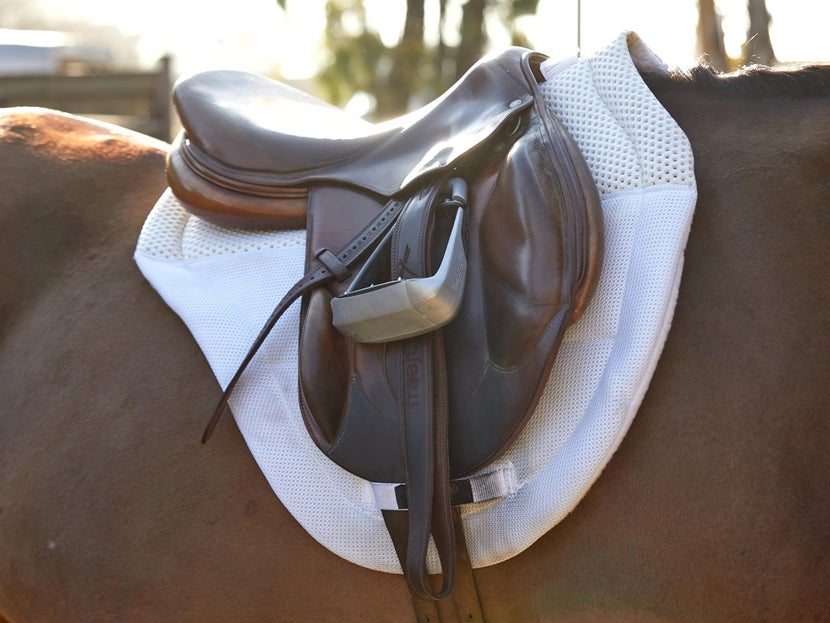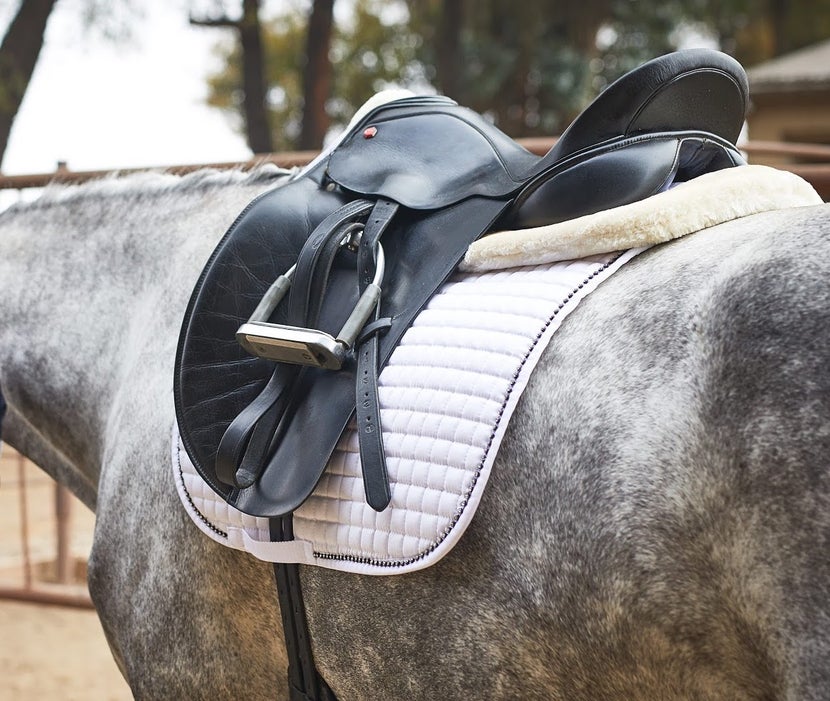How to Choose an
English Half Pad
If you are an English rider, you have probably used a half pad or at least considered its potential benefits for your horse. Usually placed atop a full English pad, these versatile pads are used to add cushioning between your saddle and your horse's back, and some can even be adjusted to alleviate minor saddle fit issues. However, a half pad is not a substitute for a well-fitting saddle. It can help with minor points but should only aid in the fit, not make up for it. Use this guide to learn if you should use a half pad, and if so, which material is best for you!
Do You Need a Half Pad?
When selecting a half pad, it's a good idea to first evaluate the fit of your saddle to your horse's back. If you're not confident in doing this yourself, utilize the knowledge of a reputable trainer—or even better, a saddle fitter. Once you have an idea of how your saddle fits, you can then decide what material and style will work best for your situation.

A saddle with a perfect fit may be better paired with a traditional full pad.
While half pads have quite a few benefits, there are times when their added substance under the saddle may actually do more harm than good. This may occur when a saddle fits the horse just right, or especially if the saddle is too narrow on the horse's back. Think about it this way: If you have shoes that fit your feet perfectly with a thin pair of socks, wearing a thicker pair will make them tight and uncomfortable even if they are the coziest socks in the world!
The same idea can apply to a half pad. If your saddle fits your horse well, adding more padding can create a situation where the saddle becomes too narrow and causes discomfort no matter what material you use.
Shims or No Shims?

Some half pads on the market are considered "shimmable," which means they have pockets for extra inserts underneath certain areas of the saddle. Depending on the half pad, the inserts may be the same material used for the rest of the pad or they may be different, such as a sheepskin pad with foam inserts.
Shimming your pad allows for minor saddle fit adjustments, which makes these types of half pads a great choice for young horses, horses coming back into training that may develop more muscle over time, and for horses with a saddle that does not fit perfectly. A shimmable half pad typically has either four or six pockets, allowing inserts to be added to the front, rear, middle, or even just one side of the saddle depending on the needs of the horse. Keep in mind if you're using a shimmable half pad, routinely check the fit of the saddle to see if you need to add or remove shims.
What Material is Best for My Horse?

Sheepskin & Wool Half Pads
Sheepskin and wool half pads are commonly used in all English disciplines. The difference between the materials is that sheepskin is still attached to the hide, making it more durable than wool, which is sewn onto a fabric backing. However, both materials have similar benefits. Depending on the thickness and density of these pads, air space between the fibers allows the pad to absorb concussion, for moments like when you sit the trot or land from a jump. A natural material is a great choice for its breathable, antimicrobial, and moisture-wicking properties, as it holds up to 30% of its weight in water.
Sheepskin and wool half pads usually have similar styles, with optional front and rear rolls that not only provide a classic look but can also help keep your saddle in place. They can be used over a standard all-purpose or dressage pad and can also be placed directly on the horse's back to take advantage of the moisture-wicking benefits.
Two downsides to sheepskin and wool half pads are their high cost and their care-intensive nature. They are typically more expensive, especially among the higher-end brands. They also require special washing detergent and need to be air-dried and re-fluffed to maintain their shape. However, choosing to put a sheepskin half pad under your saddle can be a good move for a variety of horses without specific conformational needs, especially if your saddle is a touch too wide.
| Strengths | Absorbs Concussion, Breathable, Moisture-Wicking |
| Weaknesses | High Cost, Maintenance |
| Use | All English Disciplines |
| Care | Special Detergent, Air Dried, Re-Fluffed |

Fleece Half Pads
Fleece half pads are similar to sheepskin and wool, except fleece is a synthetic material. This means they are more easily washable, but they're typically not as soft and may not wick moisture or distribute weight as effectively. However, with a similar look and a much more affordable price, fleece pads continue to be a popular alternative to both sheepskin and wool.
| Strengths | Affordable Price, Absorbs Concussion |
| Weaknesses | Does Not Wick Sweat or Distribute Weight as Well |
| Use | All English Disciplines |
| Care | Hand Wash with Mild Detergent, Allow to Air Dry |

Foam half pads can be made from a variety of materials and foam types. The two main types you'll encounter are open-cell and closed-cell foam.
Foam Half Pads
Open-Cell Foam: As the name describes, this is foam with open cells that create air pockets, allowing it to compress down then rebound back to its original thickness. A great example of open-cell material is memory foam. This type of half pad easily conforms to the shape of your horse's back and the saddle, remaining thicker under areas with less pressure.
This type of pad can absorb shock, but only up to the point where it compresses completely. The thickness of this material can also be a bit deceiving, since 1" of open-cell foam may compress down to ¼" or less. Open-cell half pads are a good choice for absorbing some shock during your ride and assisting with minor saddle fit issues.
Closed-Cell Foam: This type of foam features closed air pockets, which gives it a higher density and allows it to resist compression under pressure. Instead, closed-cell foam has more of an elastic and bouncy effect. This type of foam can help evenly distribute weight and keep out moisture—think camping mat material. The stable density can also make closed-cell foam a great choice for shims, but it should ideally be used in thin layers to avoid excess bulk. A thick closed-cell pad can create a tighter saddle fit and also cause a bounce effect throughout your ride.
| Strengths | Absorbs Shock, Aids with Minor Saddle Fitting Issues |
| Weaknesses | Can Compress Too Much, Can Create a "Bounce" Effect |
| Use | All English Disciplines |
| Care | Dependant on Material, Check Manufacturer Cleaning Instructions |
Leather Half Pads
Similar to a closed-cell foam pad, leather half pads provide a dense platform meant to minimize pressure points. Leather half pads give the option to create a smooth platform for the saddle. Having a consistent platform means very even weight distribution on the horse's back. Leather half pads do not have the compression feature, which makes them great for horses who are sensitive to uneven pressure and prefer the saddle to be placed up off their back. In addition to these attributes, leather pads are great for horses who need a prominent tent in their pads due to their strong structure. This means pulling the pads up off the horse's wither and helping create space down the gullet and horse's spine.
A downside to leather half pads is that since they are not super flexible, they don't always fit the shape of your horse's back. If your horse's spine has more curves than the pad offers, you might find that it sits on their wither or on their lower back. Additionally, since leather half pads are newer to the market and use high-quality materials, they are generally more expensive.
Leather half pads should be cleaned just like any other leather tack piece. Use a good quality leather cleaner and oil for long-term preservation. To help keep these pads clean, they should be used in conjunction with a full saddle pad.
| Strengths | Absorbs Shock, Offers Recoil with Horse's Natural Movement, Tenting Options, Easy to Clean, Super Durable |
| Weaknesses | Stiff, Doesn't Fit Every Horse, Expensive |
| Use | All English Disciplines |
| Care | Good Quality Leather Cleaner, Oil, Partner Saddle Pad, *No Cleaner With Wax* |

Gel Half Pads
Gel half pads vary in terms of structure and density, with some featuring large, gel-filled areas and others utilizing a more ventilated structure.
Half pads with a ventilated structure may have a perforated, woven, or honeycomb surface, allowing for heat and moisture dissipation, whereas a solid structure can trap both. A ventilated structure may also prevent gel from moving from an area of pressure into an area without pressure—a scenario that can actually worsen pressure points. Honeycomb or other ventilated gel pads are usually on the thinner side, making them a good choice as an extra layer of shock absorption.
Solid gel pads can be a great option if your saddle fits well, as they absorb shock and conform to your horse's back. The downside of gel is the weight, as gel is typically heavier than other materials. Most gel half pads don't maintain a contoured shape either, which can make them difficult for use with horses that have a prominent spine or withers.
| Strengths | Absorbs Shock, Conforms to Horse's Back |
| Weaknesses | Heavy, Does Not Maintain Shape |
| Use | All English Disciplines |
| Care | Wipe Down with Wet Rag, Air Dry |
FAQs
Q: Do I have to use a certain half pad in my chosen discipline?
A: No! You can use whatever half pad makes your horse happy. Most half pads are white or black, which means they won't be distracting in the show ring, and even so, not much of the pad actually peeks out from under the saddle.
Q: When should I get my saddle fitted?
A: Getting your saddle fitted or checked is important to do routinely. Especially if your horse is growing or changing shape from rehabbing. Having a happy back helps to make for a happy horse, and an ill-fitting saddle will only slow you down. If your horse is changing more frequently than you can get it checked, using a shimmable pad is a great option. When you get your saddle checked out, show your fitter the half pad you have and they can help tailor the setup to best work for your horse.
Q: Can I test half pads before committing to one?
A: Yes, you can and you should! Whether you order through Riding Warehouse or ask around the barn, testing tack before committing is a great idea. Many riders are willing to lend their tack for a ride or two in order to help a barn mate. This can be a great way to see which material your horse feels the best in.
Closing Thoughts

With ever-improving technology, companies are continually developing new and unique materials for half pads. Remember, not every half pad will work for every horse/rider/saddle combination, so it is wise to try before you buy. Asking a trainer or trusted barn mate to help with this process will aid in guaranteeing the comfort of your horse. We hope this guide helps make the choices a little less overwhelming. And if you still have questions regarding English half pads, please reach out to our customer service at 1-800-620-9145 or info@ridingwarehouse.com. Ride on!